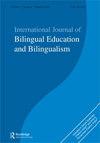Decoloniality, language and literacy. Conversation with teacher educators
IF 2.5
2区 文学
Q1 EDUCATION & EDUCATIONAL RESEARCH
International Journal of Bilingual Education and Bilingualism
Pub Date : 2023-07-20
DOI:10.1080/13670050.2023.2237640
引用次数: 0
Abstract
‘offered an analysis of a Polish piece of poetry or a commentary on his favorite heritage author’ (276). Such suggestions are valuable for all teachers of immigrant or multilingual youth. The Multilingual Adolescent Experience is a unique, critical body of work that places immigrant adolescents at the forefront of the discussion of their own needs. By interviewing students and their families about language socialization practices as they naturally occur in these students’ real lives, Machowska-Kosciak offers an illuminating and engaging view of the assets multilingual, multicultural youth could bring to the classroom if they were only given the opportunity. Adolescence, Machowska-Kosciak explains, is an era of seeking belonging ‘to something bigger’ (99) than family. The Multilingual Adolescent Experience teaches readers that immigrant teenagers may feel as though they have to choose one language, one culture to belong to. It is our responsibility, as educators, to teach them that it is possible to choose both.非殖民化、语言和识字。与教师教育者对话
“对一首波兰诗进行了分析,或者对他最喜欢的传统作家进行了评论”(276)。这些建议对所有教移民或多语青年的教师都很有价值。《多语言青少年的经历》是一本独特而重要的著作,将移民青少年置于讨论其自身需求的最前沿。Machowska-Kosciak通过采访学生和他们的家庭,了解他们在现实生活中自然发生的语言社会化实践,提供了一个具有启发性和引人入胜的观点,即如果有机会,多语言、多元文化的年轻人可以为课堂带来的资产。Machowska-Kosciak解释说,青春期是一个寻求比家庭更大的归属感的时代。《多语言青少年的经历》告诉读者,移民青少年可能会觉得他们必须选择一种语言,一种文化。作为教育者,我们有责任告诉他们两者都可以选择。
本文章由计算机程序翻译,如有差异,请以英文原文为准。
求助全文
约1分钟内获得全文
求助全文
来源期刊
CiteScore
7.90
自引率
7.10%
发文量
93
期刊介绍:
The aim of this Journal is to be thoroughly international in nature. It disseminates high-quality research, theoretical advances, international developments to foster international understanding, and to spread ideas about initiatives in bilingualism and bilingual education. The Journal seeks: • To promote theoretical and applied research into bilingual education and bilingualism. • To provide a truly international exchange, and to encourage international debates and discussions on key issues in areas of controversy in bilingual education and bilingualism. audience.

 求助内容:
求助内容: 应助结果提醒方式:
应助结果提醒方式:


